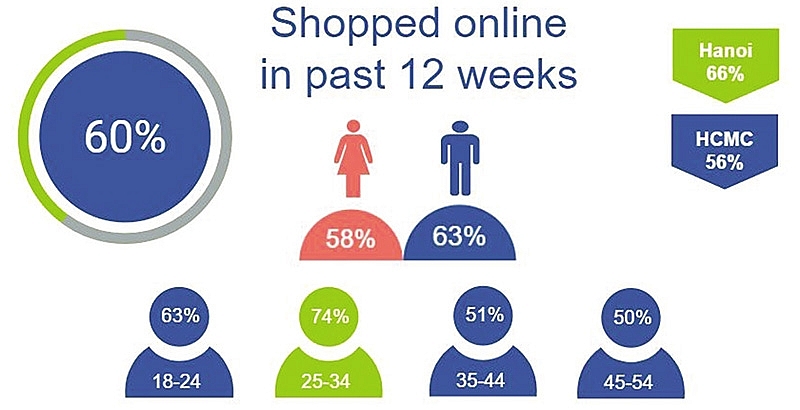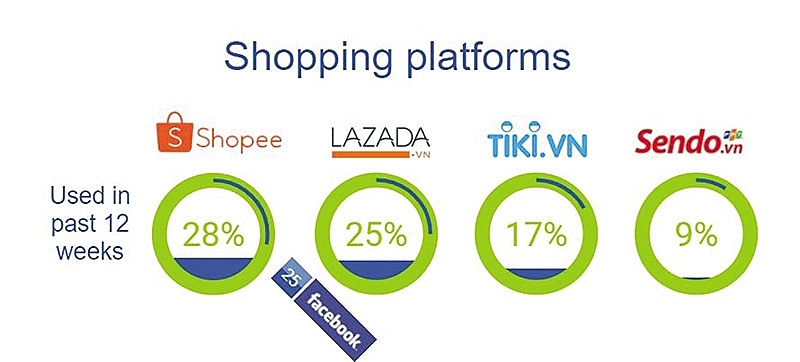Logging on to e-commerce
 |
Cimigo recently interviewed 300 men and women from Hanoi and Ho Chi Minh City, aged between 18 and 55. Results showed that food and beverage purchases are still by far the most common online purchases, being made by shoppers every three days on average. This represents a huge cultural shift in Vietnam’s eating and dining habits.
In fact, taking all online food and beverage items into account, the figure rises to almost 20 purchases a month. This is remarkable, considering that food delivery companies only begun to gain traction in Vietnam around five years ago, when there was very little scope for online ordering of general food and drink items.
As Vietnam zooms ahead of the novelty stage of e-commerce, there is really nothing that cannot be purchased online and Vietnam’s online shoppers are taking full advantage of the choice available to them. On the back of the familiarity and security of ordering food online several times a month, consumers now have confidence and trust in the wider shopping services available to them online and via mobile devices.
Two key factors are driving this retail revolution. Firstly, as commonly reported, Vietnam’s economy is booming and we are in an era of young professionals having larger disposable incomes. Alongside this are the technological advances that not only give us the platforms to shop on but the means to access them, in the form of mobile devices.
However, most purchases are still low in value. Currently, almost half of the transactions have a value of under VND300,000 ($13), with less than 10 per cent of purchases being over VND2 million ($87).
Websites versus apps
Currently, Vietnam’s online market for general purchases is dominated by four companies – Lazada, Shopee, Tiki, and Sendo – who have each built huge online marketplaces supported by sophisticated web technology and apps.
In 2018, these four online retailers enjoyed significant uptake of their apps, but this area is still dominated by the big social media companies in the country, Facebook and Zalo. Around 80 to 90 per cent of online shoppers have these apps installed, giving them immediate access to shopping at the swipe of a finger.
Mobile apps for online retailers, unsurprisingly, don’t come close to these percentages but around 40 per cent of online shoppers across all ages have installed the Lazada and Shopee apps. In the case of Shopee, over half of shoppers aged 18-35 have downloaded its mobile app.
With apps becoming such a fundamental part of our lives, we have to believe that online retailers will look to these channels as a way of increasing market share in what will become an increasingly competitive arena.
From Cimigo’s research, Facebook is now commonly used for fashion, which accounts for almost two-thirds of purchases made through the portal. The social media giant enjoys an omnipresent position and the ease with which independent retailers can create fan pages and online stores. As a result, it is not surprising that younger, fashion-conscious shoppers are migrating to Facebook instead of the malls.
Online platforms are finding their niches as well. Lazada relies heavily on fashion sales but nearly a quarter of their sales are from electronics, including gadgets and accessories, making them the leading marketplace in this sector.
Meanwhile Shopee is also big on fashion, and they are the strongest marketplace when it comes to cosmetics and personal care items. However, if we want to look at an online company that has truly captured a market segment then that would be Tiki, whose books and stationery market share exceeds all other marketplaces combined.
With online shopping still in its infancy in Vietnam, these channels have the opportunity to both strengthen their areas of specialisation as well as gain sizeable growth in the smaller segments. Product lines that are maybe not eye-catching now could well provide significant revenue streams as more Vietnamese consumers shop online.
 |
 |
| Lazada under crossfire Last week was a difficult one for Lazada.vn as the platform’s administrative oversight allowed the trading of dangerous toy guns. Several inspections have been conducted to clarify the origin of the goods, their distribution channels, as well as the identity of the sellers and buyers of the prohibited goods. Several days ago, the Ho Chi Minh City Department of Industry and Trade visited the headquarters of Recess Co., Ltd., the operator of Lazada.vn to stage an inspection related to the selling of these toy guns and components that could cause serious physical injury. “We have asked this company to provide documents and data. When the investigation is finished, we will report to the Ho Chi Minh City People’s Committee,” said a representative of the department. Meanwhile, the Department of E-commerce and Digital Economy, in collaboration with the General Department of Market Surveillance under the Ministry of Industry and Trade, are also considering looking into the severity of the violation. Earlier, dozens (even hundreds) of toy guns and components were displayed on e-commerce websites like Lazada.vn and Shopee.vn. These JinMing toy guns are 1:1 plastic replicas of M4A1 rifles produced in China and can shoot bullets made of plaster. The toy guns pack quite a punch as they can puncture beer cans at close range or break a plastic case – which means they are more than capable of causing bodily harm. |
A question of loyalty
As online retail finds its feet, it is understandable that shopping platforms and online stores make massive investments in technology and marketing. Winning customers, and keeping them loyal, is key. However, in this period of early success for e-commerce in Vietnam it seems customers are responding more to convenience and pricing than customer service and brand loyalty.
Indeed, savvy Vietnamese consumers will put their purses and wallets ahead of brand loyalty; they understand the importance of comparing prices, and looking for bargains and promotions. With so much information available at the touch of a screen or click of a mouse, it is quick and easy to compare prices between products as well as brands. Online shopping allows for much easier browsing and comparison than the traditional brick-and-mortar shopping experience.
In Cimigo’s research around 30 per cent of shoppers rated their preferred channel or marketplace highly, leaving a very large chunk of business potentially lost. Online shopping platforms have an average net promoter score of only 19 in Vietnam. In the United States, the score is 45. The dynamics and technology of online shopping in Vietnam may be hugely different from traditional shopping but customer service and loyalty is not.
The fact is that no single e-commerce website has yet cracked it. With companies continuing to understand the very new market of Vietnam, diverse strengths and weaknesses are apparent, making it interesting to see whether they continue to play to their strengths or look to improve in weaker areas in order to build market share.
Feedback from online shoppers shows that customer service is the one area where e-commerce providers can make significant improvements. As with other online services, customer satisfaction is of course ultimately the key to success and should not be ignored for the sake of revenue.
The signs are that where there is a wide product selection, backed up with strong search and comparison functionality, shoppers are happy to stay with one marketplace and not hop around looking for better prices.
What the stars mean:
★ Poor ★ ★ Promising ★★★ Good ★★★★ Very good ★★★★★ Exceptional
Related Contents
Latest News
More News
- Sustainability a core value for DKSH’s vision (January 07, 2026 | 16:00)
- People encouraged to contribute and grow at AstraZeneca Vietnam (January 07, 2026 | 15:48)
- Dat Bike accelerates sustainable mobility (January 07, 2026 | 15:24)
- Innovation to support modern healthcare development (January 07, 2026 | 10:00)
- Six localities record double-digit growth as regional performance diverges in 2025 (January 06, 2026 | 18:00)
- E-commerce market undergoes transformation amid rising competition and regulation (January 06, 2026 | 17:54)
- Vietnam’s industrial output hits seven-year high in 2025 (January 06, 2026 | 17:47)
- GELEX’s credit rating outlook upgraded to 'Positive' by VIS Rating (January 06, 2026 | 16:49)
- Finance sector lays firm groundwork for 2026 after major reform (January 06, 2026 | 15:30)
- Vietnam’s seafood exports surpass $11 billion in 2025 (January 06, 2026 | 08:51)

 Tag:
Tag:




















 Mobile Version
Mobile Version